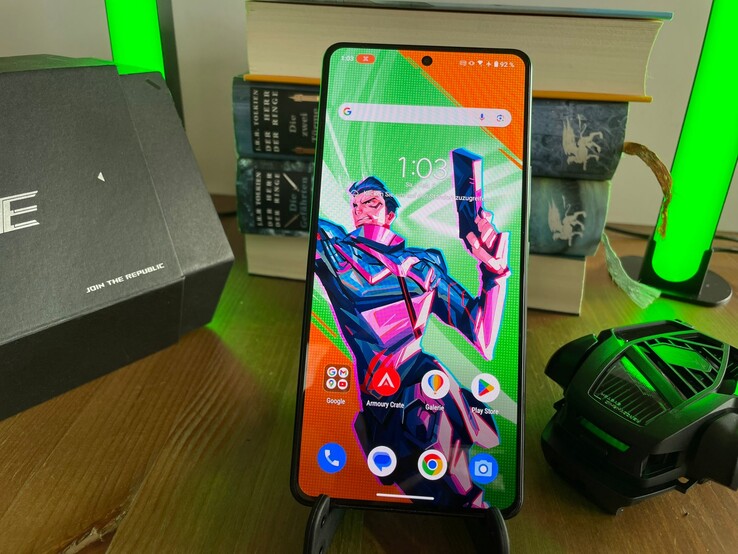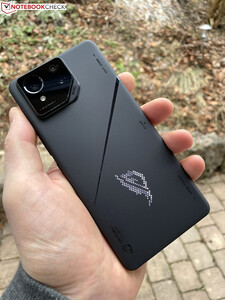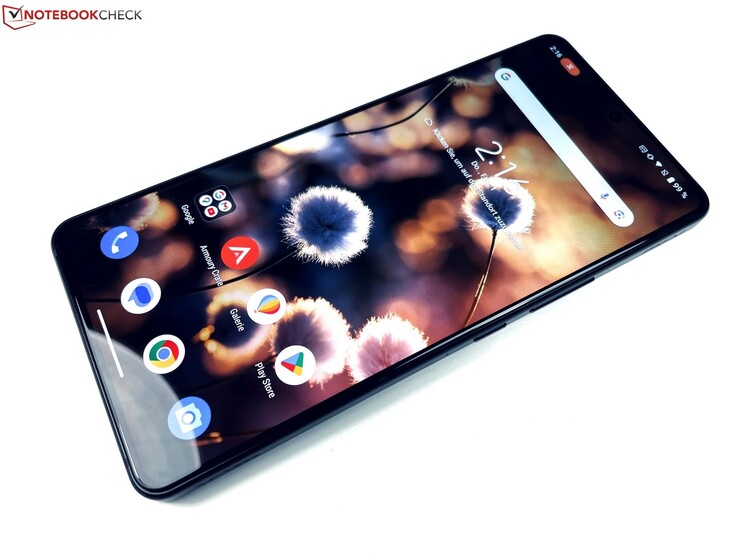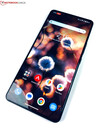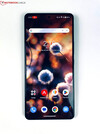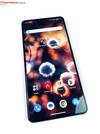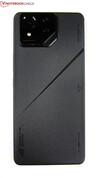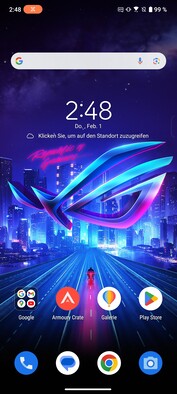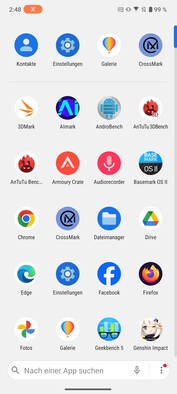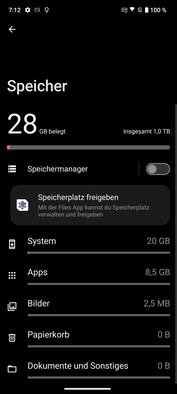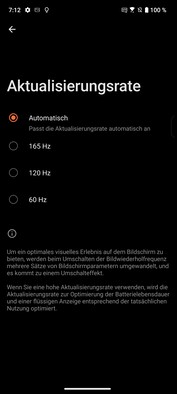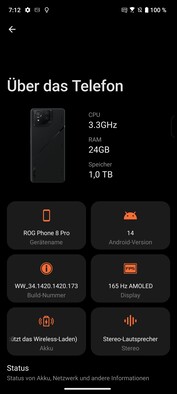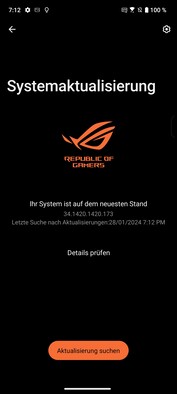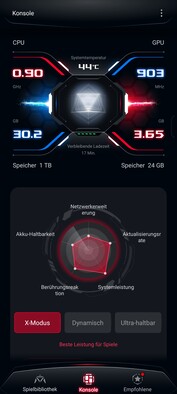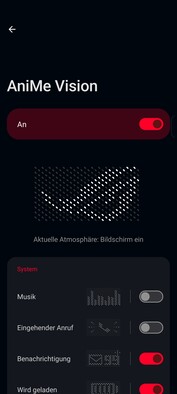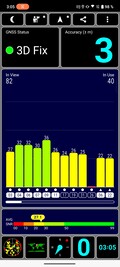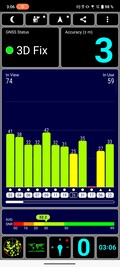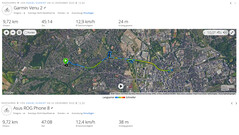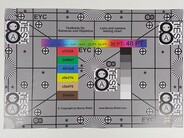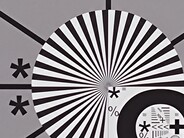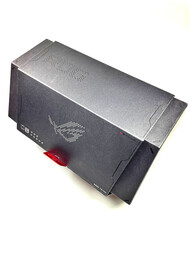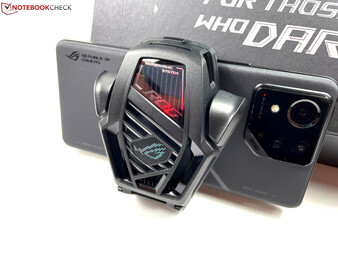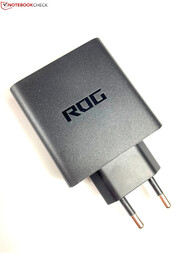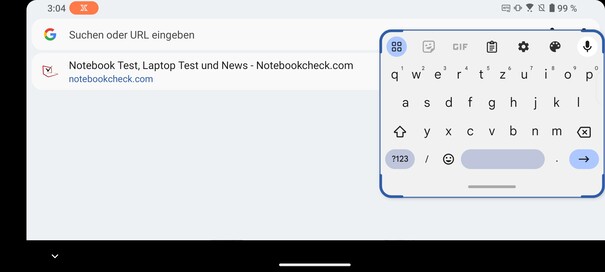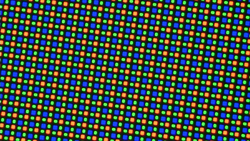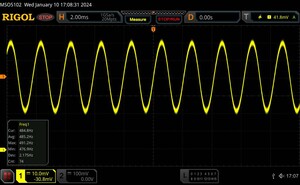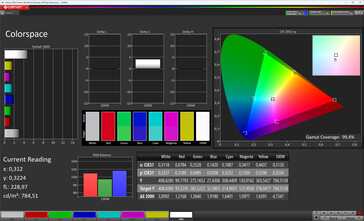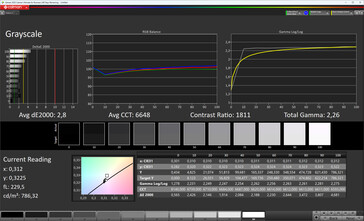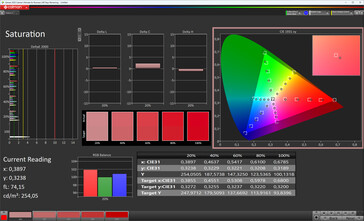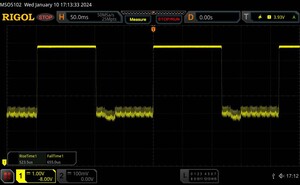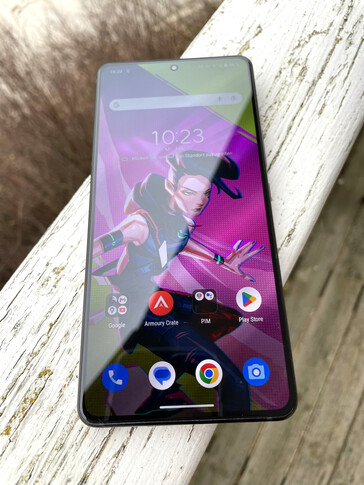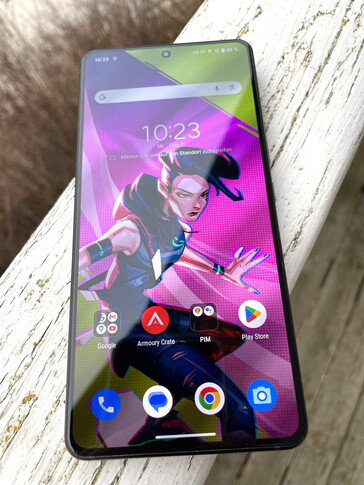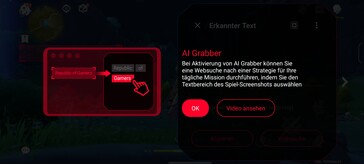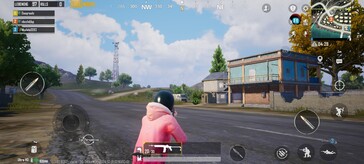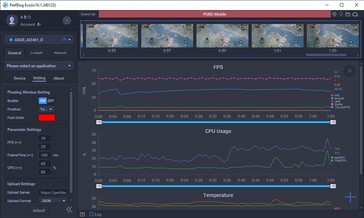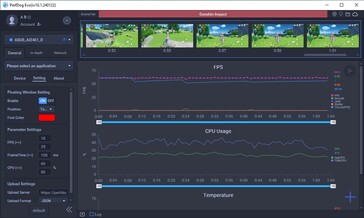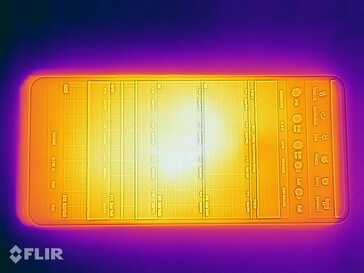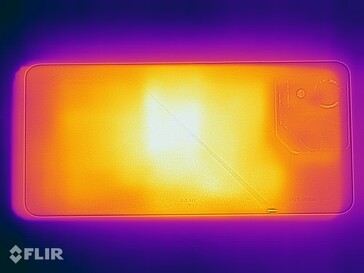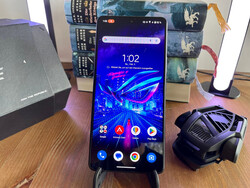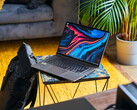Asus ROG Phone 8 Pro review: From gaming smartphone to premium smartphone
Asus has revamped its gaming smartphone. Like its predecessor, the ROG Phone 8 utilizes the fastest hardware available on the market, but has a new overall focus in terms of concept of use.
The underlying focus is still on gaming, which is unmistakably reflected in the 'Republic of Gamers' suffix. However, the gaming niche has become too small for the Asus smartphone, which is now intended to be a premium smartphone suitable for the masses. Our review reveals whether Asus succeeds in this regard.
The ROG Phone 8 is available in two model variants. The first is simply called the ROG Phone 8, while we reviewed the second variant, the ROG Phone 8 Pro. Both differ from each other in only two respects, namely memory and accessories.
While the ROG Phone 8 has 12 GB of LPDDR5X RAM and 256 GB of UFS 4.0 memory, the ROG Phone 8 Pro has up to 24 GB of RAM and up to 1 TB of storage. In addition, only the ROG Phone 8 Pro comes with the AeroActive Cooler X active fan, which docks onto the smartphone via a second USB port.
Possible competitors in comparison
Rating | Date | Model | Weight | Drive | Size | Resolution | Price |
|---|---|---|---|---|---|---|---|
| 88.6 % v7 (old) | 02 / 2024 | Asus ROG Phone 8 Pro SD 8 Gen 3, Adreno 750 | 225 g | 1 TB UFS 4.0 Flash | 6.78" | 2400x1080 | |
| 91.1 % v7 (old) | 12 / 2023 | Apple iPhone 15 Pro Max A17 Pro, A17 Pro GPU | 221 g | 256 GB NVMe | 6.70" | 2796x1290 | |
| 90.2 % v7 (old) | 05 / 2023 | Asus ROG Phone 7 Ultimate SD 8 Gen 2, Adreno 740 | 239 g | 512 GB UFS 4.0 Flash | 6.78" | 2448x1080 | |
| 89 % v7 (old) | 12 / 2023 | Google Pixel 8 Pro Tensor G3, Mali-G715 MP7 | 213 g | 128 GB UFS 3.1 Flash | 6.70" | 2992x1344 | |
| 90.1 % v7 (old) | 07 / 2023 | Honor Magic5 Pro SD 8 Gen 2, Adreno 740 | 219 g | 512 GB UFS 4.0 Flash | 6.81" | 2848x1312 | |
| 86.8 % v7 (old) | 02 / 2024 | Nubia RedMagic 9 Pro SD 8 Gen 3, Adreno 750 | 229 g | 512 GB UFS 4.0 Flash | 6.80" | 2480x1116 | |
| 89.4 % v7 (old) | 12 / 2023 | Xiaomi 14 Pro SD 8 Gen 3, Adreno 750 | 223 g | 256 GB UFS 4.0 Flash | 6.73" | 3200x1440 |
Case - Discreet glass housing with IP68 certification
At first glance, one can no longer tell that the Asus ROG Phone 8 Pro, which is only available in the Phantom Black color, is a gaming smartphone. Unlike the ROG Phone 7 Ultimate, there is no longer the eye-catching two-color design. The ROG Phone 8 Pro's only stand-out detail is a glossy black horizontal stripe on the back cover.
The small additional display on the back is also no longer visible. Although it is still there, it now remains invisible when notifications or other information are not displayed. The Republic of Gamers logo is also more restrained. This is an unmistakable sign of the smartphone's gaming DNA, no longer in a contrasting color, but rather in glossy black lettering on the matte glass back, making it much more discreet.
The ROG Phone 8 Pro is a very well-made smartphone with flush and even gaps and feels like a premium phone overall. In contrast to its 239-gram predecessor, it has become noticeably lighter at 225 grams and is also slimmer at 8.9 millimeters (ROG Phone 7 Ultimate: 10.3 mm). This has no impact on stability. The ROG Phone 8 Pro did not give way to warping or denting in stress tests during our review. It is also dust and waterproof according to IP68.
The OLED panel protected by Gorilla Glass Victus 2 has also been slimmed down. Its display edges have become narrower on all four sides, giving the ROG Phone 8 Pro a fresher look than its predecessor. In numerical terms, the display-to-surface ratio has improved from 82% to 88%.
Features - Two USB-C ports and up to 24 GB RAM in the Asus ROG Phone 8 Pro
Asus offers the ROG Phone 8 Pro in two configurations. The first with 16 GB LPDDR5X of RAM and 512 GB of UFS 4.0 storage officially costs $1199. For the second variant with 24 GB RAM and 1 TB storage, the ROG Phone 8 Pro Edition, Asus charges $1499. There is no slot for microSD memory cards.
The two USB-C ports are unusual for a smartphone. As usual, one is located at the bottom of the phone, operates at USB 3.2 Gen.2 speed and supports PD 3.0 in addition to Quick Charge 5.0. In our copy test with the M2.SSD Samsung 980 Pro in the Asus ROG Strix Arion Case (USB 3.2 Gen. 2), the ROG Phone 8 Pro achieved a transfer rate of 299.8 MB/s - definitely not a bad value, but a little poor given the 10 GBit/s bandwidth of the USB 3.2 Gen.2 port.
The second USB-C port on the long left side is used to connect the external fan, but can also be used to charge the ROG Phone 8 Pro while gaming. This is particularly practical when holding the smartphone in landscape format. With a standard connection, the USB cable would get in the way.
Charging via the second USB-C port also works when the AeroActive Cooler X is docked, as this in turn has a USB-C port. This is also essential if the external fan is set to run at the maximum "Frozen" power level, as the power supply unit must be connected to its USB-C port.
The ROG Phone 8 Pro is one of the few high-end smartphones with a 3.5 mm jack connection. Two nano SIM cards fit into the SIM slot. An always-on display is also included and can be displayed in an energy-saving manner thanks to the LPTO panel, ideally at a refresh rate of just 1 Hz.
Software - Android 14 and 4 years of updates
The ROG Phone 8 Pro runs Android 14 together with the manufacturer's own user interface ROG UI. Asus plans to provide its smartphone with updates and 2 OS upgrade over a period of 4 years. At the time of review in early February, the ROG Phone 8 Pro received an update that brought its Android security patches up to the date of December 1, 2023.
Apart from the futuristic standard Shadow Elite design, the ROG UI is largely no different from stock Android. Users can also choose the standard Android theme at any time.
Some gaming features are integrated into the ROG UI. The highest performance mode, X Mode, is displayed directly in the top line next to the time. In addition to the performance modes, the Armory Crate app can also be used to configure all important smartphone components such as the AirTrigger, the back cover display and the external fan. And users can use a special overlay to optimize game settings directly while gaming.
Communication and GNSS - WiFi 7 and a range of cellular frequencies
The Asus ROG Phone 8 Pro is very well positioned in terms of cellular frequency coverage. With 25 4G bands and 20 5G bands, you should be able to get a signal practically anywhere. Bluetooth 5.3 and NFC also form part of the smartphone's communication hardware.
The Asus smartphone supports WiFi 7, however, we were unable to test the smartphone's WiFi 7 speeds due to a lack of corresponding routers. Nevertheless, transfer rates with WiFi 6E are impressive, with up to 1734 MBit/s in sending and a peak value of 1505 MBit/s in receiving. The high-end comparison devices all achieve very similar transfer rates.
| Networking | |
| Asus ROG Phone 8 Pro | |
| iperf3 receive AXE11000 | |
| iperf3 transmit AXE11000 | |
| iperf3 transmit AXE11000 6GHz | |
| iperf3 receive AXE11000 6GHz | |
| Apple iPhone 15 Pro Max | |
| iperf3 receive AXE11000 | |
| iperf3 transmit AXE11000 | |
| iperf3 transmit AXE11000 6GHz | |
| iperf3 receive AXE11000 6GHz | |
| Asus ROG Phone 7 Ultimate | |
| iperf3 receive AXE11000 | |
| iperf3 transmit AXE11000 | |
| iperf3 transmit AXE11000 6GHz | |
| iperf3 receive AXE11000 6GHz | |
| Google Pixel 8 Pro | |
| iperf3 receive AXE11000 | |
| iperf3 transmit AXE11000 | |
| iperf3 transmit AXE11000 6GHz | |
| iperf3 receive AXE11000 6GHz | |
| Honor Magic5 Pro | |
| iperf3 receive AXE11000 | |
| iperf3 transmit AXE11000 | |
| Nubia RedMagic 9 Pro | |
| iperf3 receive AXE11000 | |
| iperf3 transmit AXE11000 | |
| iperf3 transmit AXE11000 6GHz | |
| iperf3 receive AXE11000 6GHz | |
| Xiaomi 14 Pro | |
| iperf3 receive AXE11000 | |
| iperf3 transmit AXE11000 | |
| iperf3 transmit AXE11000 6GHz | |
| iperf3 receive AXE11000 6GHz | |
| Average of class Smartphone | |
| iperf3 receive AXE11000 | |
| iperf3 transmit AXE11000 | |
| iperf3 transmit AXE11000 6GHz | |
| iperf3 receive AXE11000 6GHz | |
For localization, the ROG Phone 8 Pro uses satellite navigation services ranging from GPS (L1, L5), Galileo (E1, E5a), Glonass (L1), Beidou (B1, B2a) to QZSS (L1, L5), which is almost always done in dual-band. Outdoors and indoors, our location is established at an accuracy of three meters.
On a short bike ride, we compared the smartphone's positioning skills with those of the Garmin Venu 2, which shows that the ROG Phone 8 Pro is well suited to navigational tasks. For the most part, it records the route just as precisely as the fitness smartwatch.
Telephony and voice quality
The Asus ROG Phone 8 Pro has space for two nano SIM cards. Both can be selected as the preferred SIM card for voice calls, SMS or data services. VoLTE and WLAN calls are supported. However, we did not find an option for eSIM activation.
With its three microphones, the ROG Phone 8 Pro ensures good voice quality. The integrated noise suppression effectively filters out ambient noise, which also works well in hands-free mode.
Cameras - Gimbal-stabilized triple camera with Sony IMX890
Asus has given its smartphone a major camera update, which was also necessary in order to live up to its own premium claim, as cameras usually only play second fiddle on gaming smartphones. Although the ROG Phone 7 Ultimate offers solid fare, it cannot compete with other flagship phones in terms of image quality. The ROG Phone 8 Pro does some things better, but not enough for the highest honors this time either.
The selfie camera remains unchanged at 32 MP and shoots 8 MP photos via 4-in-1 pixel binning, but takes better pictures, especially in difficult lighting conditions. With its 90° field of view, the camera is well suited for group selfies. You can switch between a 1x zoom and a 0.7x ultra-wide-angle view as required. The selfie camera records videos in maximum Full HD at 30 frames per second.
The Sony IMX890 replaces the Sony IMX766 for the 50-MP main camera. The image sensor in 1/1.56" format is also found in the Nothing Phone (2) and works with an f/1.9 aperture, which corresponds to a full-frame equivalent of 23.8 millimeters. When taking photos, the main camera uses 4x pixel binning as standard and is supported by gimbal stabilization, which works with videos up to Full HD and 60 FPS. Alternatively, the full 50 MP can also be used for photos.
The main camera takes good pictures in daylight that are characterized by natural-looking colors and a high level of image sharpness. The very short shutter lag is also impressive. However, if you look closely, the photos are sometimes heavily sharpened and no longer look particularly realistic. This can be clearly seen, for example, on the lakeshore in the second daylight photo or generally with object edges. In our low-light shots, the main camera visibly struggled to produce well-lit and sharp photos and also garnished them with a slight blue cast.
The 13-MP ultra-wide-angle camera delivers decent image quality in good lighting conditions, but nothing special, especially for the price range in which the ROG Phone 8 Pro operates. The telephoto camera, which takes after the macro camera of the ROG Phone 7 Ultimate, also delivers standard fare. The telephoto lens has a resolution of 32 MP, 3x optical zoom, optical image stabilization and takes solid pictures.
The biggest improvement in the camera module is the video recordings, as these are stabilized excellently by the integrated gimbal. Overall, the ROG Phone 8 Pro makes much better videos than the ROG Phone 7 Ultimate and is only just behind the flagship competition in terms of detail and image sharpness. Videos are recorded at up to 8K at 24 frames per second. Switching between the three lenses is possible up to a maximum of 4K at 30 FPS.
Image comparison
Choose a scene and navigate within the first image. One click changes the position on touchscreens. One click on the zoomed-in image opens the original in a new window. The first image shows the scaled photograph of the test device.
Daylight photo 1Daylight photo 2Ultra wide angle5x zoomLow light photoUnder controlled lighting conditions, the main camera captures colors very precisely if the ambient light is right. At 1 lux of residual light, however, the images in the photo lab are bluish and the test chart can only be recognized with difficulty.
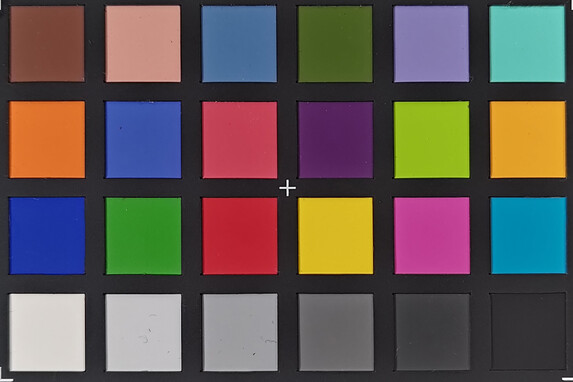
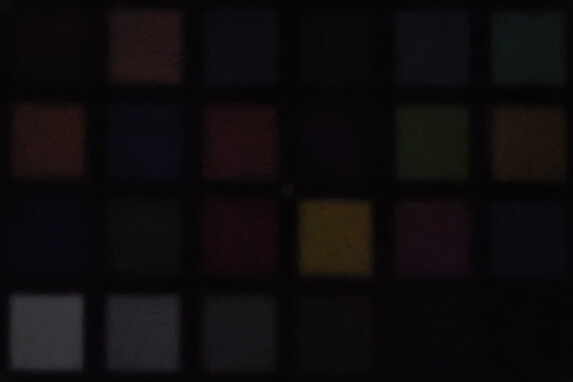
Accessories and warranty - Active fan and 65-watt power supply unit included
The Asus ROG Phone 8 Pro comes with a 65-watt power adapter, a USB-C cable, a transparent protective case, a SIM tool, a quick start guide and a warranty card. The 24GB/1TB version also includes the AeroActive Cooler X active fan and a protective case.
Asus also offers the ROG Tessen Game Controller for the ROG Phone 8 Pro. Like the external fan, it connects to the smartphone via USB-C and transforms it into a handheld device. However, the game controller was not yet available at the time of review.
Asus provides a 24-month warranty on the ROG Phone 8 Pro.
Input devices & operation - Programmable second display on the back cover
The ROG Phone 8 Pro's capacitive touchscreen responds extremely quickly and precisely to touch. The same applies to menus, apps and games. With the Snapdragon 8 Gen 3 and a whopping 24 GB of RAM under the hood, the ROG Phone 8 Pro handles all inputs and swipe gestures without any delay. This high level of performance did not change at all during our tests, no matter how many apps we opened or how much we used the smartphone. The X-axis linear motor provides powerful feedback.
The ROG Phone 8 Pro can be unlocked biometrically via the optical fingerprint sensor integrated into the display, which also does its job very quickly and reliably. Alternatively, the selfie camera can be used to set up 2D facial recognition, which is not quite as secure.
The programmable secondary display on the back cover is called AniMe Vision and can display animated information via its 341 mini LEDs (such as incoming calls, battery status, time, new notifications and so forth). What exactly should be displayed can be configured via the Armory Crate app. There, users can choose from predefined animations, but can also create their own animations.
Display - 2500 nits bright LTPO panel with 165 Hz
The 2400 x 1080 pixel resolution LTPO OLED panel of the ROG Phone 8 Pro supports HDR10 as well as HDR HLG and runs at a refresh rate of up to 165 Hz. In the default setting, this is automatically adjusted to the content being displayed. However, it can also be set manually to 60, 120 or 165 Hz.
The resolution and frame rate have remained almost the same as in the predecessor - the ROG Phone 7 Ultimate has a resolution of 2448 x 1080 with the same form factor, which is only slightly higher. However, the OLED panel of the ROG Phone 8 Pro has improved significantly in terms of brightness.
With a pure white background, the screen shines at an average of 1698 cd/m². With an even distribution of light and dark image areas (APL18), the brightness even increases to 2502 cd/m² and thus precisely meets the manufacturer's specification of 2500 nits. The luminance of HDR content is approximately the same (2596 cd/m²). If you adjust the brightness manually with the brightness sensor deactivated, you can get a maximum of 806 cd/m² out of the display. At the lowest brightness setting, we still measured 6.39 cd/m², which is comparatively bright and can appear quite glaring, especially in the dark.
The OLED panel uses pulse width modulation to control brightness, but flickers at a comparatively high frequency of 485 Hz, which should also be fine for sensitive people. Flicker protection can also be activated in the display settings, which reduces the PWM flickering at low brightness.
| |||||||||||||||||||||||||
Brightness Distribution: 98 %
Center on Battery: 1699 cd/m²
Contrast: ∞:1 (Black: 0 cd/m²)
ΔE ColorChecker Calman: 1.9 | ∀{0.5-29.43 Ø4.78}
ΔE Greyscale Calman: 2.8 | ∀{0.09-98 Ø5}
100% sRGB (Calman 2D)
Gamma: 2.26
CCT: 6648 K
| Asus ROG Phone 8 Pro OLED, 2400x1080, 6.8" | Apple iPhone 15 Pro Max OLED, 2796x1290, 6.7" | Asus ROG Phone 7 Ultimate AMOLED, 2448x1080, 6.8" | Google Pixel 8 Pro OLED, 2992x1344, 6.7" | Honor Magic5 Pro OLED, 2848x1312, 6.8" | Nubia RedMagic 9 Pro AMOLED, 2480x1116, 6.8" | Xiaomi 14 Pro AMOLED, 3200x1440, 6.7" | |
|---|---|---|---|---|---|---|---|
| Screen | 8% | 6% | 12% | -6% | 12% | 3% | |
| Brightness middle (cd/m²) | 1699 | 1102 -35% | 1010 -41% | 1510 -11% | 1291 -24% | 1035 -39% | 1025 -40% |
| Brightness (cd/m²) | 1698 | 1102 -35% | 1016 -40% | 1467 -14% | 1289 -24% | 1031 -39% | 1046 -38% |
| Brightness Distribution (%) | 98 | 98 0% | 95 -3% | 92 -6% | 96 -2% | 96 -2% | 95 -3% |
| Black Level * (cd/m²) | |||||||
| Colorchecker dE 2000 * | 1.9 | 1.1 42% | 1.3 32% | 1.1 42% | 1.7 11% | 1 47% | 1.1 42% |
| Colorchecker dE 2000 max. * | 4.7 | 3.1 34% | 2.5 47% | 3.8 19% | 4.4 6% | 1.9 60% | 2.9 38% |
| Greyscale dE 2000 * | 2.8 | 1.6 43% | 1.6 43% | 1.7 39% | 2.9 -4% | 1.6 43% | 2.2 21% |
| Gamma | 2.26 97% | 2.19 100% | 2.24 98% | 2.23 99% | 2.28 96% | 2.25 98% | 2.25 98% |
| CCT | 6648 98% | 6555 99% | 6405 101% | 6670 97% | 6472 100% | 6368 102% | 6622 98% |
* ... smaller is better
Screen Flickering / PWM (Pulse-Width Modulation)
| Screen flickering / PWM detected | 485 Hz | ||
The display backlight flickers at 485 Hz (worst case, e.g., utilizing PWM) . The frequency of 485 Hz is relatively high, so most users sensitive to PWM should not notice any flickering. However, there are reports that some users are still sensitive to PWM at 500 Hz and above, so be aware. In comparison: 53 % of all tested devices do not use PWM to dim the display. If PWM was detected, an average of 8105 (minimum: 5 - maximum: 343500) Hz was measured. | |||
Series of measurements at a fixed zoom level and different brightness settings
How the ROG Phone 8 Pro displays content can be adjusted via a total of 5 picture modes. The default setting is Optimal, but we get the best picture quality in Natural. In this mode, the OLED panel scores with a color and grayscale display in the ideal range and also meets picture parameters such as color temperature and gamma almost perfectly.
Display Response Times
| ↔ Response Time Black to White | ||
|---|---|---|
| 1.14 ms ... rise ↗ and fall ↘ combined | ↗ 0.6525 ms rise | |
| ↘ 0.483 ms fall | ||
| The screen shows very fast response rates in our tests and should be very well suited for fast-paced gaming. In comparison, all tested devices range from 0.1 (minimum) to 240 (maximum) ms. » 4 % of all devices are better. This means that the measured response time is better than the average of all tested devices (20.2 ms). | ||
| ↔ Response Time 50% Grey to 80% Grey | ||
| 1.18 ms ... rise ↗ and fall ↘ combined | ↗ 0.5235 ms rise | |
| ↘ 0.655 ms fall | ||
| The screen shows very fast response rates in our tests and should be very well suited for fast-paced gaming. In comparison, all tested devices range from 0.165 (minimum) to 636 (maximum) ms. » 4 % of all devices are better. This means that the measured response time is better than the average of all tested devices (31.6 ms). | ||
The ROG Phone 8 Pro always remains easy to read outdoors, even on bright days, so there are unlikely to be any limitations in summer. The wintry light conditions prevailing at the time of review did not pose any challenges for the viewing-angle-stable OLED panel.
Performance - ROG Phone 8 Pro with Snapdragon 8 Gen 3
The Asus ROG Phone 8 Pro is equipped with the Snapdragon 8 Gen 3, which makes the smartphone one of the fastest on the market today. The high-end SoC is supported by the Adreno 750 graphics chip and has 24 GB of LPDDR5X RAM and 1 TB of UFS 4.0 storage in our test sample. The performance level is correspondingly high.
In the synthetic benchmarks, the Asus ROG Phone 8 Pro, together with the Nubia RedMagic 9 Pro and the Xiaomi 14 Pro, take the top spots on the Android side, as the same SoC is used in all three smartphones. In Geekbench 6, however, the trio is beaten by the Apple iPhone 15 Pro Max.
For Geekbench 6, we carried out two measurements with the ROG Phone 8 Pro in the highest performance mode, X mode: once without a fan and once with a fan plugged in. With an active fan, the smartphone achieved slightly higher scores in both single-core and multi-core performance, but the overall difference to the "fanless" test is only slight.
| UL Procyon AI Inference for Android - Overall Score NNAPI | |
| Google Pixel 8 Pro | |
| Average of class Smartphone (3769 - 81594, n=135, last 2 years) | |
| Nubia RedMagic 9 Pro | |
| Asus ROG Phone 8 Pro | |
| Xiaomi 14 Pro | |
| Asus ROG Phone 7 Ultimate | |
| Average Qualcomm Snapdragon 8 Gen 3 (11487 - 18370, n=22) | |
| Honor Magic5 Pro | |
In the graphics tests, the ROG Phone 8 Pro once again shares the lead with the Nubia RedMagic 9 Pro and the Xiaomi 14 Pro. But thanks to its refresh rate of 165 Hz, the Asus smartphone is ahead in the GFXBench onscreen tests. Overall, the Apple iPhone 15 Pro Max can't do much against so much GPU power.
GFXBench (DX / GLBenchmark) 2.7: T-Rex Onscreen | 1920x1080 T-Rex Offscreen
GFXBench 3.0: on screen Manhattan Onscreen OGL | 1920x1080 1080p Manhattan Offscreen
GFXBench 3.1: on screen Manhattan ES 3.1 Onscreen | 1920x1080 Manhattan ES 3.1 Offscreen
GFXBench: on screen Car Chase Onscreen | 1920x1080 Car Chase Offscreen | on screen Aztec Ruins High Tier Onscreen | 2560x1440 Aztec Ruins High Tier Offscreen | on screen Aztec Ruins Normal Tier Onscreen | 1920x1080 Aztec Ruins Normal Tier Offscreen | 3840x2160 4K Aztec Ruins High Tier Offscreen
| 3DMark / Wild Life Extreme Unlimited | |
| Asus ROG Phone 8 Pro | |
| Nubia RedMagic 9 Pro | |
| Apple iPhone 15 Pro Max | |
| Asus ROG Phone 7 Ultimate | |
| Honor Magic5 Pro | |
| Google Pixel 8 Pro | |
| 3DMark / Wild Life Extreme | |
| Asus ROG Phone 8 Pro | |
| Nubia RedMagic 9 Pro | |
| Asus ROG Phone 7 Ultimate | |
| Apple iPhone 15 Pro Max | |
| Honor Magic5 Pro | |
| Google Pixel 8 Pro | |
| 3DMark / Wild Life Unlimited Score | |
| Asus ROG Phone 8 Pro | |
| Nubia RedMagic 9 Pro | |
| Apple iPhone 15 Pro Max | |
| Asus ROG Phone 7 Ultimate | |
| Honor Magic5 Pro | |
| Google Pixel 8 Pro | |
| 3DMark / Sling Shot Extreme (ES 3.1) Unlimited Physics | |
| Nubia RedMagic 9 Pro | |
| Asus ROG Phone 8 Pro | |
| Asus ROG Phone 7 Ultimate | |
| Honor Magic5 Pro | |
| Google Pixel 8 Pro | |
| 3DMark / Sling Shot Extreme (ES 3.1) Unlimited Graphics | |
| Asus ROG Phone 8 Pro | |
| Nubia RedMagic 9 Pro | |
| Asus ROG Phone 7 Ultimate | |
| Honor Magic5 Pro | |
| Google Pixel 8 Pro | |
| 3DMark / Sling Shot Extreme (ES 3.1) Unlimited | |
| Nubia RedMagic 9 Pro | |
| Asus ROG Phone 8 Pro | |
| Asus ROG Phone 7 Ultimate | |
| Honor Magic5 Pro | |
| Google Pixel 8 Pro | |
| GFXBench (DX / GLBenchmark) 2.7 / T-Rex Onscreen | |
| Asus ROG Phone 8 Pro | |
| Asus ROG Phone 7 Ultimate | |
| Google Pixel 8 Pro | |
| Xiaomi 14 Pro | |
| Nubia RedMagic 9 Pro | |
| Honor Magic5 Pro | |
| Apple iPhone 15 Pro Max | |
| GFXBench (DX / GLBenchmark) 2.7 / T-Rex Offscreen | |
| Xiaomi 14 Pro | |
| Asus ROG Phone 8 Pro | |
| Honor Magic5 Pro | |
| Nubia RedMagic 9 Pro | |
| Asus ROG Phone 7 Ultimate | |
| Apple iPhone 15 Pro Max | |
| Google Pixel 8 Pro | |
| GFXBench 3.0 / Manhattan Onscreen OGL | |
| Asus ROG Phone 8 Pro | |
| Asus ROG Phone 7 Ultimate | |
| Google Pixel 8 Pro | |
| Xiaomi 14 Pro | |
| Nubia RedMagic 9 Pro | |
| Honor Magic5 Pro | |
| Apple iPhone 15 Pro Max | |
| GFXBench 3.0 / 1080p Manhattan Offscreen | |
| Xiaomi 14 Pro | |
| Nubia RedMagic 9 Pro | |
| Asus ROG Phone 8 Pro | |
| Asus ROG Phone 7 Ultimate | |
| Apple iPhone 15 Pro Max | |
| Honor Magic5 Pro | |
| Google Pixel 8 Pro | |
| GFXBench 3.1 / Manhattan ES 3.1 Onscreen | |
| Asus ROG Phone 8 Pro | |
| Asus ROG Phone 7 Ultimate | |
| Xiaomi 14 Pro | |
| Google Pixel 8 Pro | |
| Nubia RedMagic 9 Pro | |
| Honor Magic5 Pro | |
| Apple iPhone 15 Pro Max | |
| GFXBench 3.1 / Manhattan ES 3.1 Offscreen | |
| Xiaomi 14 Pro | |
| Nubia RedMagic 9 Pro | |
| Asus ROG Phone 8 Pro | |
| Asus ROG Phone 7 Ultimate | |
| Honor Magic5 Pro | |
| Apple iPhone 15 Pro Max | |
| Google Pixel 8 Pro | |
| GFXBench / Car Chase Onscreen | |
| Asus ROG Phone 8 Pro | |
| Asus ROG Phone 7 Ultimate | |
| Xiaomi 14 Pro | |
| Google Pixel 8 Pro | |
| Honor Magic5 Pro | |
| Apple iPhone 15 Pro Max | |
| Nubia RedMagic 9 Pro | |
| GFXBench / Car Chase Offscreen | |
| Xiaomi 14 Pro | |
| Nubia RedMagic 9 Pro | |
| Asus ROG Phone 8 Pro | |
| Honor Magic5 Pro | |
| Asus ROG Phone 7 Ultimate | |
| Apple iPhone 15 Pro Max | |
| Google Pixel 8 Pro | |
| GFXBench / Aztec Ruins High Tier Onscreen | |
| Asus ROG Phone 7 Ultimate | |
| Xiaomi 14 Pro | |
| Google Pixel 8 Pro | |
| Asus ROG Phone 8 Pro | |
| Nubia RedMagic 9 Pro | |
| Honor Magic5 Pro | |
| Apple iPhone 15 Pro Max | |
| GFXBench / Aztec Ruins High Tier Offscreen | |
| Xiaomi 14 Pro | |
| Honor Magic5 Pro | |
| Asus ROG Phone 8 Pro | |
| Nubia RedMagic 9 Pro | |
| Asus ROG Phone 7 Ultimate | |
| Apple iPhone 15 Pro Max | |
| Google Pixel 8 Pro | |
| GFXBench / Aztec Ruins Normal Tier Onscreen | |
| Asus ROG Phone 7 Ultimate | |
| Xiaomi 14 Pro | |
| Google Pixel 8 Pro | |
| Asus ROG Phone 8 Pro | |
| Honor Magic5 Pro | |
| Nubia RedMagic 9 Pro | |
| Apple iPhone 15 Pro Max | |
| GFXBench / Aztec Ruins Normal Tier Offscreen | |
| Xiaomi 14 Pro | |
| Asus ROG Phone 8 Pro | |
| Asus ROG Phone 7 Ultimate | |
| Nubia RedMagic 9 Pro | |
| Honor Magic5 Pro | |
| Apple iPhone 15 Pro Max | |
| Google Pixel 8 Pro | |
| GFXBench / 4K Aztec Ruins High Tier Offscreen | |
| Xiaomi 14 Pro | |
| Nubia RedMagic 9 Pro | |
| Asus ROG Phone 8 Pro | |
| Honor Magic5 Pro | |
| Asus ROG Phone 7 Ultimate | |
| Apple iPhone 15 Pro Max | |
| Google Pixel 8 Pro | |
Browser performance on the ROG Phone 8 Pro is very good and can be seen in everyday use on very fast websites that can be scrolled through quickly. However, the Asus smartphone only ranks in the upper midfield in the browser benchmarks.
| Jetstream 2 - 2.0 Total Score | |
| Apple iPhone 15 Pro Max (Safari Mobile 17) | |
| Nubia RedMagic 9 Pro (Edge 120) | |
| Nubia RedMagic 9 Pro (Chrome 120) | |
| Xiaomi 14 Pro (Chrome 120) | |
| Asus ROG Phone 8 Pro (Edge 121.0.2277.84) | |
| Average Qualcomm Snapdragon 8 Gen 3 (64.1 - 241, n=24) | |
| Average of class Smartphone (23.8 - 387, n=149, last 2 years) | |
| Asus ROG Phone 7 Ultimate (Chrome 112.0.5615.48) | |
| Honor Magic5 Pro (Chrome 111) | |
| Google Pixel 8 Pro (Chrome 117) | |
| Speedometer 2.0 - Result 2.0 | |
| Apple iPhone 15 Pro Max (Safari Mobile 17) | |
| Average of class Smartphone (15.2 - 643, n=122, last 2 years) | |
| Nubia RedMagic 9 Pro (Edge 120) | |
| Nubia RedMagic 9 Pro (Chrome 120) | |
| Average Qualcomm Snapdragon 8 Gen 3 (69.6 - 311, n=19) | |
| Asus ROG Phone 8 Pro (Edge 121.0.2277.84) | |
| Google Pixel 8 Pro (Chrome 117) | |
| Xiaomi 14 Pro (Chrome 120) | |
| Honor Magic5 Pro (Chrome 111) | |
| Asus ROG Phone 7 Ultimate (Chrome 112.0.5615.48) | |
| WebXPRT 4 - Overall | |
| Xiaomi 14 Pro (Chrome 120) | |
| Asus ROG Phone 8 Pro (Edge 121.0.2277.84) | |
| Nubia RedMagic 9 Pro (Edge 120) | |
| Average Qualcomm Snapdragon 8 Gen 3 (69 - 212, n=22) | |
| Average of class Smartphone (27 - 306, n=145, last 2 years) | |
| Asus ROG Phone 7 Ultimate (Chrome 112.0.5615.48) | |
| Google Pixel 8 Pro (Chrome 117) | |
| Honor Magic5 Pro (Chrome 111) | |
| WebXPRT 3 - Overall | |
| Apple iPhone 15 Pro Max (Safari Mobile 17) | |
| Average Qualcomm Snapdragon 8 Gen 3 (142 - 310, n=9) | |
| Asus ROG Phone 7 Ultimate (Chrome 112.0.5615.48) | |
| Xiaomi 14 Pro (Chrome 120) | |
| Nubia RedMagic 9 Pro (Edge 120) | |
| Asus ROG Phone 8 Pro (Edge 121.0.2277.84) | |
| Average of class Smartphone (38 - 380, n=31, last 2 years) | |
| Google Pixel 8 Pro (Chrome 117) | |
| Octane V2 - Total Score | |
| Apple iPhone 15 Pro Max (Safari Mobile 17) | |
| Nubia RedMagic 9 Pro (Edge 120) | |
| Nubia RedMagic 9 Pro (Chrome 120) | |
| Asus ROG Phone 8 Pro (Edge 121.0.2277.84) | |
| Xiaomi 14 Pro (Chrome 120) | |
| Average Qualcomm Snapdragon 8 Gen 3 (25953 - 75238, n=27) | |
| Google Pixel 8 Pro (Chrome 117) | |
| Average of class Smartphone (2228 - 121337, n=197, last 2 years) | |
| Asus ROG Phone 7 Ultimate (Chrome 112.0.5615.48) | |
| Honor Magic5 Pro (Chrome 111) | |
| Mozilla Kraken 1.1 - Total | |
| Average of class Smartphone (257 - 28190, n=154, last 2 years) | |
| Honor Magic5 Pro (Chrome 111) | |
| Asus ROG Phone 7 Ultimate (Chrome 112.0.5615.48) | |
| Asus ROG Phone 8 Pro (Edge 121.0.2277.84) | |
| Google Pixel 8 Pro (Chrome 117) | |
| Xiaomi 14 Pro (Chrome 120) | |
| Average Qualcomm Snapdragon 8 Gen 3 (510 - 2066, n=25) | |
| Nubia RedMagic 9 Pro (Chrome 120) | |
| Nubia RedMagic 9 Pro (Edge 120) | |
| Apple iPhone 15 Pro Max (Safari Mobile 17) | |
* ... smaller is better
UFS 4.0 storage gives the Asus smartphone a very high data throughput. Even large apps install quickly and load in no time at all.
| Asus ROG Phone 8 Pro | Asus ROG Phone 7 Ultimate | Honor Magic5 Pro | Nubia RedMagic 9 Pro | Average 1 TB UFS 4.0 Flash | Average of class Smartphone | |
|---|---|---|---|---|---|---|
| AndroBench 3-5 | -7% | -31% | 4% | -10% | -42% | |
| Sequential Read 256KB (MB/s) | 4016.67 | 3429.17 -15% | 3344.12 -17% | 4164.08 4% | 3428 ? -15% | 2228 ? -45% |
| Sequential Write 256KB (MB/s) | 3153.4 | 3061.82 -3% | 2651.87 -16% | 3199.98 1% | 3211 ? 2% | 1852 ? -41% |
| Random Read 4KB (MB/s) | 434.63 | 450.1 4% | 267.91 -38% | 442.82 2% | 395 ? -9% | 296 ? -32% |
| Random Write 4KB (MB/s) | 648 | 572.05 -12% | 298.31 -54% | 691.17 7% | 543 ? -16% | 339 ? -48% |
Gaming - In-game overlay and additional AI-supported functions
The Armory Crate app acts as a control center for all gaming settings. At the same time, it can also be displayed as an overlay in the game and provides direct access to the current performance mode, as well as features such as macro recording, a do-not-disturb mode and an FPS counter.
The ROG Phone 8 Pro's gaming repertoire also includes AI-powered features such as X Sense 2.0 and AI Grabber. The former automatically picks up items in supported games such as Genshin Impact, while the AI Grabber recognizes keywords in dialogues and starts a Google search on request. This allows you to search for solutions to a quest directly in the game, for example, or to retrieve other tips relevant to the game.
The AirTriggers known from the Asus ROG Phone 7 Ultimate are also on the ROG Phone 8 Pro. The AirTriggers are two ultrasonic sensors located on the corners of the long right side of the smartphone and function as additional L and R controller buttons. If the phone is held in landscape format, both can be easily reached with the index fingers. With the Armory Crate app, the AirTrigger buttons can be dragged over the controls in the game UI and can then trigger actions such as calling up the menu or changing weapons.
The ROG Phone 8 Pro can run in three performance modes. The most powerful is called X Mode (or X Mode+ with the AeroActive Cooler X docked) and can be activated directly via the notification screen. Other performance modes include Dynamic (balanced settings for everyday use) and the power-saving Ultra Durable mode. The performance settings can be adjusted individually for each mode.
In testing, the ROG Phone 8 Pro ran games very smoothly. Even graphically very demanding titles such as Genshin Impact run smoothly across the screen at maximum settings. However, the Asus smartphone refused to work with our Gamebench test tool, which we normally use to determine frame rates. Alternatively, we used the Perfdog tool.
Perfdog registered the maximum framerate of 60 FPS in the HRD/Extreme setting on the ROG Phone 8 Pro; in UltraHDR/Ultra, the highest selectable setting, this was 40 FPS. In both cases, the frame rate is presumably limited for energy-saving reasons. The smartphone only offers a 90 FPS mode in the lowest graphics mode. Genshin Impact ran at a constant 60 FPS at the highest detail level. More could also be possible here, but the game is curtailed by the smartphone.
Emissions - Powerful stereo speakers
Temperature
With the Snapdragon 8 Gen 3, the ROG Phone 8 Pro has to cool a high-end SoC that produces a lot of waste heat. In the 1-hour stress test with the demanding Burnout benchmark, it pulls through without crashes or any error messages, unlike competitors such as the Xiaomi 14 Pro. However, the smartphone heats up to 46.8 °C and gets uncomfortably warm in places.
As 3DMark's Wild Life stress tests show, the ROG Phone 8 Pro is unable to maintain its performance under continuous load, but still achieved good results with a stability score of 77% and 79.2%, respectively. In everyday use, users will not notice any thermal throttling because the Asus smartphone still offers plenty of performance, even with the handbrake slightly applied.
In the stress test, it makes a big difference whether we run it with or without the external fan. When the AeroActive Cooler X is attached to the smartphone, the stability scores of the 3D Mark Wild Life stress test improve to 92.7% and 90.8%, respectively. For users who play for long periods of time and want to squeeze out maximum performance, the fan is the best choice. The fan can automatically adapt its cooling mode to the current system load, but it does get quite loud at higher speeds.
(-) The maximum temperature on the upper side is 46.8 °C / 116 F, compared to the average of 35.2 °C / 95 F, ranging from 21.9 to 247 °C for the class Smartphone.
(-) The bottom heats up to a maximum of 46 °C / 115 F, compared to the average of 34 °C / 93 F
(+) In idle usage, the average temperature for the upper side is 25.1 °C / 77 F, compared to the device average of 32.9 °C / 91 F.
3DMark Wild Life Stress Test
| 3DMark | |
| Wild Life Stress Test Stability | |
| Asus ROG Phone 8 Pro | |
| Asus ROG Phone 8 Pro | |
| Asus ROG Phone 7 Ultimate | |
| Nubia RedMagic 9 Pro | |
| Apple iPhone 15 Pro Max | |
| Google Pixel 8 Pro | |
| Honor Magic5 Pro | |
| Wild Life Extreme Stress Test | |
| Asus ROG Phone 7 Ultimate | |
| Nubia RedMagic 9 Pro | |
| Asus ROG Phone 8 Pro | |
| Asus ROG Phone 8 Pro | |
| Google Pixel 8 Pro | |
| Apple iPhone 15 Pro Max | |
| Honor Magic5 Pro | |
| Solar Bay Stress Test Stability | |
| Nubia RedMagic 9 Pro | |
| Asus ROG Phone 8 Pro | |
| Honor Magic5 Pro | |
| Apple iPhone 15 Pro Max | |
Speakers
The stereo speakers of the ROG Phone 8 Pro impress with powerful sound, in which even bass tones can be heard. Even without headphones, the sound experience is quite good.
External audio devices can be connected to the smartphone via the very low-noise 3.5 mm audio jack (SNR: 100.75 dBFS) or via Bluetooth 5.3. The ROG Phone 8 Pro supports Bluetooth codecs ranging from AAC, SBC, aptX, aptX HD, aptX Adaptive, LDAC, LC3 to Opus.
Asus ROG Phone 8 Pro audio analysis
(+) | speakers can play relatively loud (92.2 dB)
Bass 100 - 315 Hz
(-) | nearly no bass - on average 21.2% lower than median
(+) | bass is linear (4.8% delta to prev. frequency)
Mids 400 - 2000 Hz
(±) | reduced mids - on average 5.1% lower than median
(+) | mids are linear (4.2% delta to prev. frequency)
Highs 2 - 16 kHz
(±) | higher highs - on average 5.6% higher than median
(+) | highs are linear (3.3% delta to prev. frequency)
Overall 100 - 16.000 Hz
(±) | linearity of overall sound is average (17.3% difference to median)
Compared to same class
» 11% of all tested devices in this class were better, 8% similar, 81% worse
» The best had a delta of 11%, average was 35%, worst was 134%
Compared to all devices tested
» 31% of all tested devices were better, 8% similar, 60% worse
» The best had a delta of 4%, average was 24%, worst was 134%
Xiaomi 14 Pro audio analysis
(+) | speakers can play relatively loud (90.5 dB)
Bass 100 - 315 Hz
(-) | nearly no bass - on average 21.5% lower than median
(±) | linearity of bass is average (7.3% delta to prev. frequency)
Mids 400 - 2000 Hz
(+) | balanced mids - only 4.7% away from median
(+) | mids are linear (6% delta to prev. frequency)
Highs 2 - 16 kHz
(±) | higher highs - on average 5.3% higher than median
(+) | highs are linear (4.9% delta to prev. frequency)
Overall 100 - 16.000 Hz
(±) | linearity of overall sound is average (16% difference to median)
Compared to same class
» 5% of all tested devices in this class were better, 4% similar, 91% worse
» The best had a delta of 11%, average was 35%, worst was 134%
Compared to all devices tested
» 24% of all tested devices were better, 5% similar, 70% worse
» The best had a delta of 4%, average was 24%, worst was 134%
Battery life - Wireless charging up to 15 watts
Power consumption
The ROG Phone 8 Pro is characterized by low power consumption. Its overall power consumption is 20% lower than that of other reviewed smartphones, which also use the Snapdragon 8 Gen 3.
The 5500 mAh battery can be charged with up to 65 watts via the supplied power adapter. In testing, a full recharge takes 48 minutes. The ROG Phone 8 Pro supports wireless charging according to the Qi standard with up to 15 watts.
| Off / Standby | |
| Idle | |
| Load |
|
Key:
min: | |
| Asus ROG Phone 8 Pro 5500 mAh | Apple iPhone 15 Pro Max 4422 mAh | Asus ROG Phone 7 Ultimate 6000 mAh | Google Pixel 8 Pro 5050 mAh | Honor Magic5 Pro 5100 mAh | Xiaomi 14 Pro 4880 mAh | Average Qualcomm Snapdragon 8 Gen 3 | Average of class Smartphone | |
|---|---|---|---|---|---|---|---|---|
| Power Consumption | -24% | 19% | -19% | -4% | -12% | -49% | -28% | |
| Idle Minimum * (Watt) | 0.82 | 0.5 39% | 0.75 9% | 0.63 23% | 0.91 -11% | 0.89 -9% | 0.969 ? -18% | 0.842 ? -3% |
| Idle Average * (Watt) | 0.96 | 1.97 -105% | 0.85 11% | 1.47 -53% | 1.63 -70% | 1.05 -9% | 1.721 ? -79% | 1.439 ? -50% |
| Idle Maximum * (Watt) | 1.19 | 1.99 -67% | 1.14 4% | 1.55 -30% | 1.67 -40% | 1.11 7% | 1.891 ? -59% | 1.624 ? -36% |
| Load Average * (Watt) | 7.3 | 3.36 54% | 3.52 52% | 8.45 -16% | 2.61 64% | 9.03 -24% | 8.91 ? -22% | 7.03 ? 4% |
| Load Maximum * (Watt) | 7.3 | 10.43 -43% | 6.01 18% | 8.63 -18% | 4.57 37% | 9.06 -24% | 12.1 ? -66% | 11.3 ? -55% |
* ... smaller is better
Power consumption: Geekbench (150 cd/m²)
Power consumption: GFXBench (150 cd/m²)
Battery life
Good battery life rounds off the ROG Phone 8 Pro's features. The smartphone endured a good 15.5 hours of simulated web surfing, which we carried out with the display brightness adjusted at 150 cd/m². When playing videos in a continuous loop, it even lasts almost 25 hours.
Overall, the battery life is on a par with the competition. The comparatively poor result under load can be disregarded, as we carried this test out with the Burnout benchmark as an alternative because the ROG Phone 8 Pro refused to install the less demanding Stability Test, which we use as standard.
| Asus ROG Phone 8 Pro 5500 mAh | Apple iPhone 15 Pro Max 4422 mAh | Asus ROG Phone 7 Ultimate 6000 mAh | Google Pixel 8 Pro 5050 mAh | Honor Magic5 Pro 5100 mAh | Nubia RedMagic 9 Pro 6500 mAh | Xiaomi 14 Pro 4880 mAh | |
|---|---|---|---|---|---|---|---|
| Battery runtime | 71% | 55% | -6% | 27% | 12% | 4% | |
| Reader / Idle (h) | 39.6 | 58.6 48% | 40.8 3% | 22.4 -43% | 43 9% | 33.3 -16% | |
| H.264 (h) | 25 | 33.6 34% | 25.9 4% | 18.7 -25% | 20.8 -17% | 24 -4% | |
| WiFi v1.3 (h) | 15.5 | 19.4 25% | 17.5 13% | 12.7 -18% | 17.9 15% | 17.3 12% | 15 -3% |
| Load (h) | 2.3 | 6.4 178% | 6.9 200% | 3.7 61% | 4.6 100% | 3.2 39% |
Pros
Cons
Verdict on the Asus ROG Phone 8 Pro
The ROG Phone 8 Pro is a very solid smartphone that impresses with extremely comprehensive features. Highlights include the lightning-fast Snapdragon 8 Gen 3, a maximum of 24 GB of RAM and 1 TB of storage, WiFi 7, long battery life and the OLED LTPO display, which can reach up to 2500 cd/m² and smoothly adjust its frame rate between 1 Hz and 165 Hz.
Asus is breaking new ground with its high-end smartphone because, unlike its predecessor, it is no longer purely a gaming smartphone, but now appeals to a much broader target group thanks to its subtle appearance and improved hardware. In addition, its high-quality glass casing has become noticeably thinner and lighter and is now also dust and waterproof thanks to IP68 certification. Nevertheless, the ROG Phone 8 Pro still has gaming DNA and continues to fulfill its role as a gaming smartphone very well.
The Asus ROG Phone 8 Pro successfully manages the balancing act between gaming smartphone and premium phone. However, it is not cheap.
A few disadvantages prevent the ROG Phone 8 Pro from achieving the highest honors. The biggest point of criticism is that it does not come close to the cameras of other premium smartphones, but only offers a level of quality that can be described as just above average at best. The option of activating an eSIM is also lacking. Otherwise, the ROG Phone 8 Pro leaves little to be desired.
Alternatives to the Asus ROG Phone 8 Pro include the Nubia RedMagic 9 Pro, which is in the same performance class and is also geared towards gaming. The Xiaomi 14 Pro, is similarly powerful and, like the Nubia RedMagic 9 Pro, is available for less than $800.
Price and availability
On Asus' webstore, the Asus ROG Phone 8 Pro costs $1199 if you opt for 16 GB RAM and 512 GB storage. Our review device version, with 24 GB RAM and 1 TB storage, costs $1499. At the time of review, the smartphone is yet to reach other retailers such as Amazon.
Asus ROG Phone 8 Pro
- 02/08/2024 v7 (old)
Manuel Masiero
Transparency
The selection of devices to be reviewed is made by our editorial team. The test sample was provided to the author as a loan by the manufacturer or retailer for the purpose of this review. The lender had no influence on this review, nor did the manufacturer receive a copy of this review before publication. There was no obligation to publish this review. As an independent media company, Notebookcheck is not subjected to the authority of manufacturers, retailers or publishers.
This is how Notebookcheck is testing
Every year, Notebookcheck independently reviews hundreds of laptops and smartphones using standardized procedures to ensure that all results are comparable. We have continuously developed our test methods for around 20 years and set industry standards in the process. In our test labs, high-quality measuring equipment is utilized by experienced technicians and editors. These tests involve a multi-stage validation process. Our complex rating system is based on hundreds of well-founded measurements and benchmarks, which maintains objectivity. Further information on our test methods can be found here.




